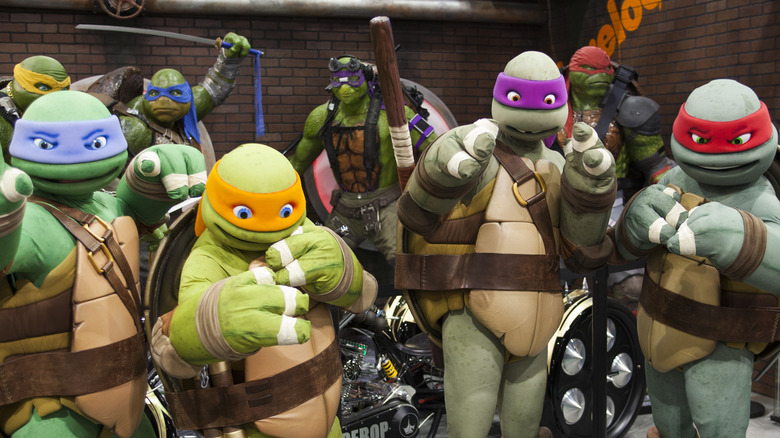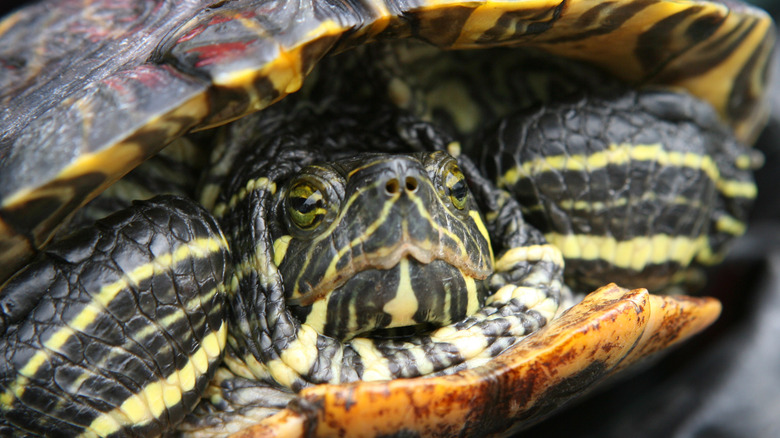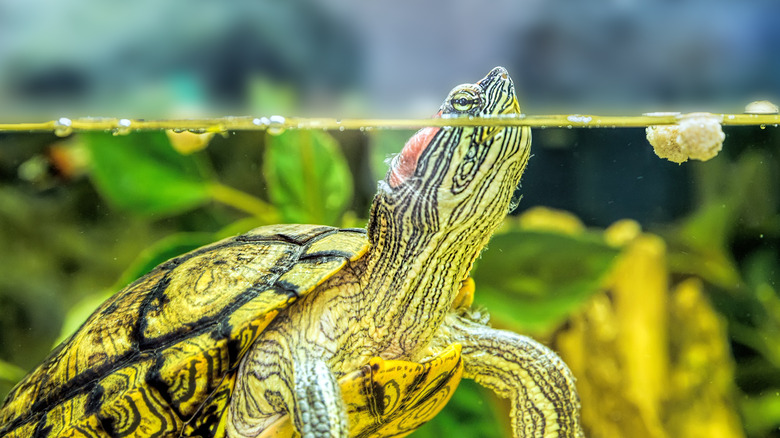The Tragic Effect That Teenage Mutant Ninja Turtles Had On Real Turtles
The Teenage Ninja Mutant Turtle franchise started off as a joke. In 1983, struggling comic artists Kevin Eastman and Peter Laird were doodling back and forth and ended up creating a turtle character with a ninja's equipment. "Ninja Turtles," was a funny combination of animal and warrior that stuck, and the legendary quartet was born, according to Mental Floss. Co-creators Eastman and Laird named the four brothers after great Renaissance artists Leonardo, Raphael, Donatello, and Michelangelo.
By the '90s, these doodles had come to life in an animated series with lots of pizza, and the characters had stolen the hearts of millions of viewers. Leonardo, Michelangelo, Raphael, and Donatello could be found on breakfast cereals and frozen pizzas, and at one time beat out the competition to become the most popular boys' toy line (via Den of Geek). Nearly three decades later, the original sketch of the Teenage Mutant Ninja Turtles would sell for $71,700 (per Mental Floss). Cowabunga!
A turtle trend gone wrong
In addition to all that plastic production, the franchise also inadvertently contributed to a different kind of environmental crisis, according to The Daily Beast. Soon after the rise of "Turtle Mania," parents began buying red-eared terrapin turtles in masses for their children. After all, what kid who was a fan of the show wouldn't want their own Ninja Turtle sidekick to keep The Shredder and other foes at bay?
Between 1989 to 1997, in the height of the Ninja Turtles' popularity, the number of terrapins plucked from U.S. farms and shipped overseas reached nearly 9 million, more than double that of the amount shipped prior to 1989, according to a 2014 study in PLoS One. The problem was particularly pronounced in England: Roughly 250,000 of these turtles were imported into the country in the early '90s from their American homelands, relative to 33,000 imported in the late '80s, pre-TMNT (per The Daily Beast).
However, children outgrew these pets long before their 30-year lifespan was up, and parents started "setting them free" in local rivers and streams (via Inverse). The problem was, these turtles were non-native in many places and disrupted ecosystems by eating ducklings and other amphibians. Plus, turtles can spread disease and force other animals to compete more for their food, according to Inverse.
Protecting the turtles
The Teenage Mutant Ninja Turtles can't take all the blame for the widespread distribution of terrapins in the '90s. Many consumers in China and Taiwan also purchased turtles from the U.S. to be used in medicines and Buddhist ceremonies (per Inverse). In fact, the brothers were relatively eco-friendly compared to their other comic book protagonists, with a whole segment of the show dedicated to "Turtle Tips," on how to save energy and protect the environment (via The Daily Beast).
It was TMNT fans and turtle-lovers alike who ended up coming to the terrapins' rescue. Although these types of turtles are still an existing invasive species in many regions of the world, organizations sprouted up to raise awareness about the issue and protect them from harm — from the Kent Turtle Sanctuary, Secret World, and the Turtle Tally in the United Kingdom to the American Tortoise Rescue in the States (via Inverse, The Daily Beast). Turtle Power!


